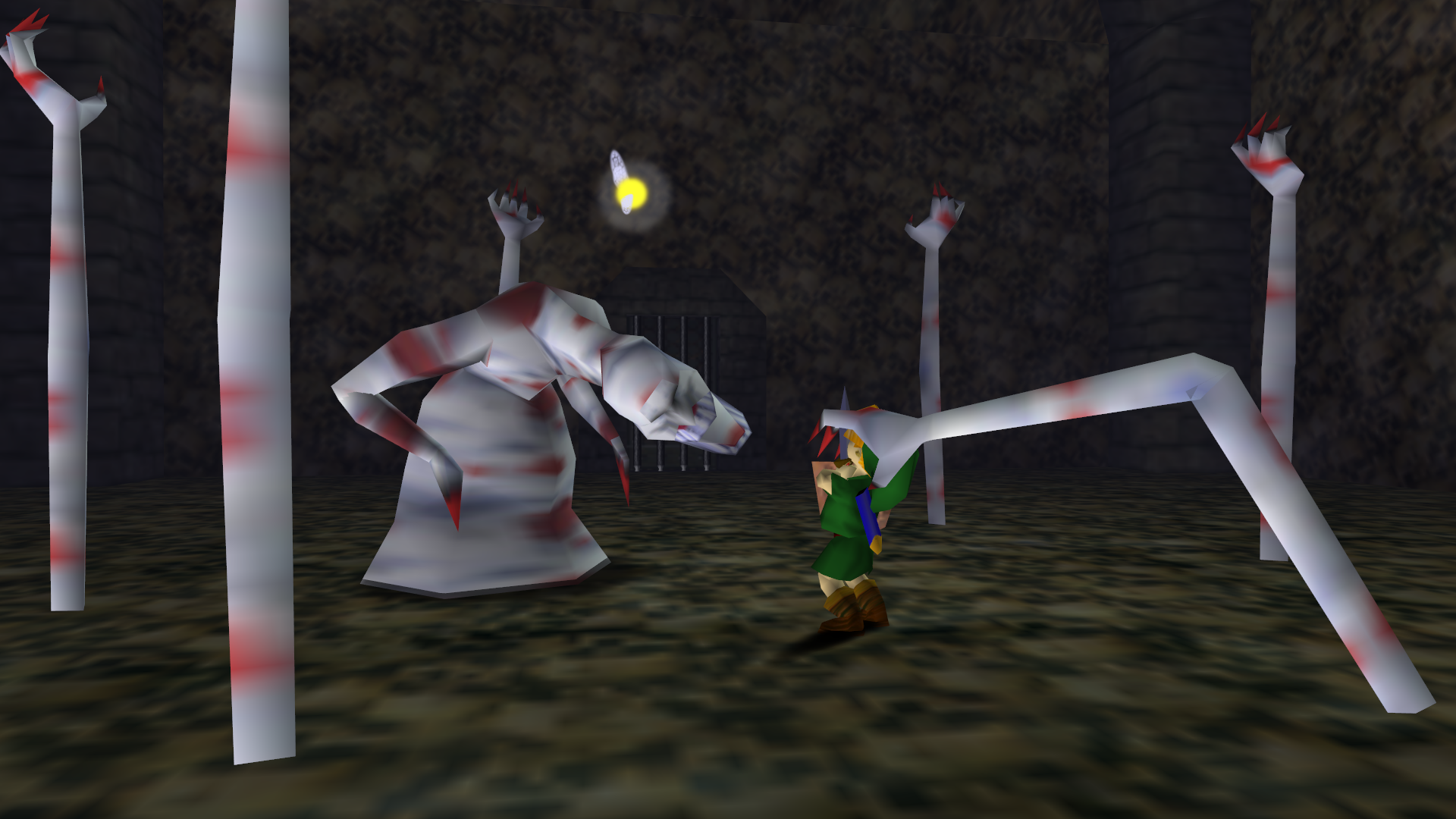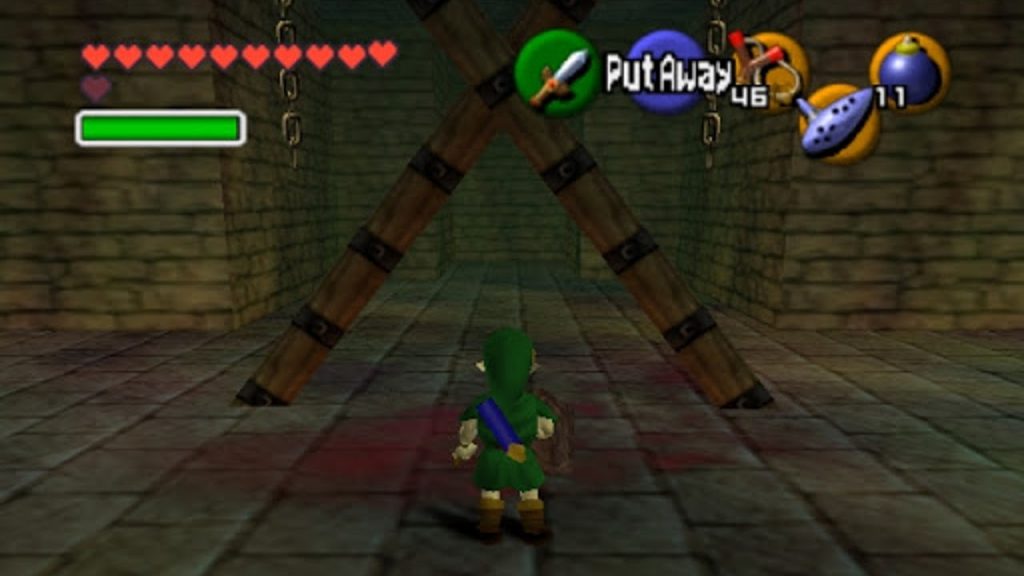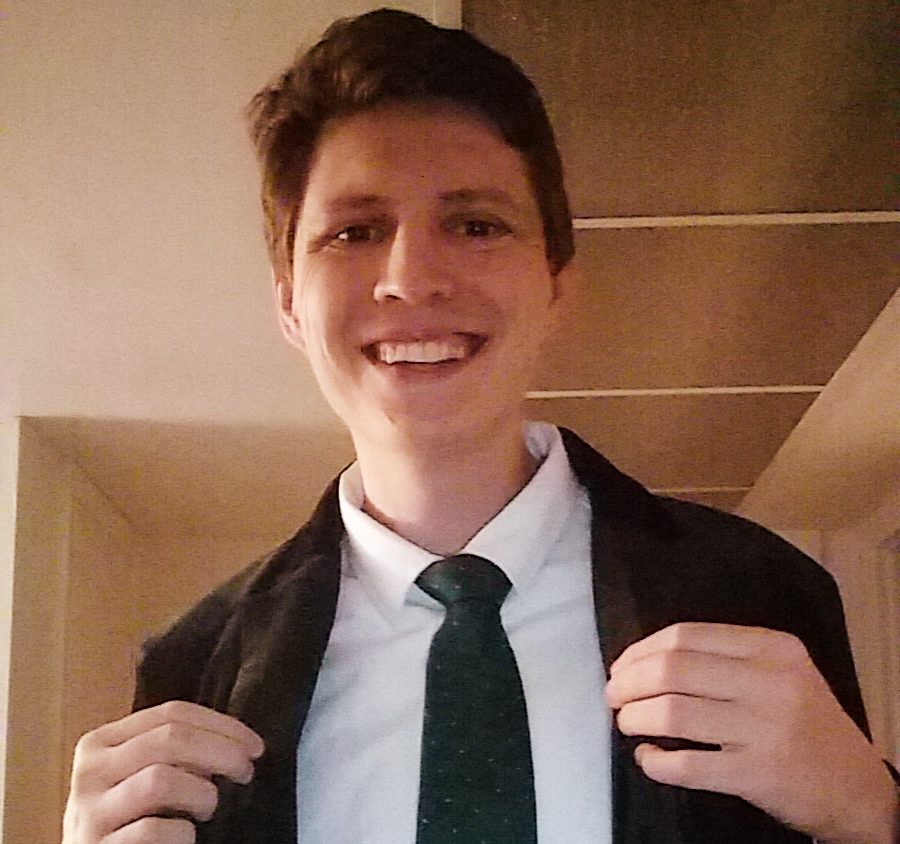Ocarina of Time’s “Bottom of the Well” Remains The Zelda Series’ Most Haunting Area
Posted on October 31 2020 by Sean Gadus

“Abandon Every Hope, Who Enters Here” – (Dante Alighieri, The Divine Comedy)
Horror is not a common part of the Legend of Zelda series. While the series has dipped its toe into dark and suspenseful moments, the series has almost always maintained a heroic, optimistic tone. As an eight or nine year old, I entered my first real playthrough of Ocarina of Time with this vision of Zelda scoured into my head. Ocarina of Time was the first video game I played seriously, the first game I truly loved. I experienced the game as a thrilling adventure filled with heroic deed and wild adventure. While there were dark moments throughout the first half of Ocarina of Time, they fit neatly into Link’s heroic journey.
With that mindset, I entered a mini-dungeon located beneath Kakariko Village and unwittingly stepped into a terrifying, nightmarish maze that completely melted my young brain. The Bottom of the Well is murky, dank sewer filled with disorienting false walls and grotesque imagery. With enemies like ReDeads, Wallmasters, Bubbles, and the notorious Dead Hands, The Bottom of the Well is my choice for darkest area in the Zelda series. While other areas like the Shadow Temple, the Arbiter’s Grounds and Ikana Canyon dabble with haunting and dark atmosphere, the Bottom of the Well feels like a singularity, a moment when the Zelda team was willing to push the envelope with a clever and terrifying house of horrors. The mini-dungeon was so haunting that it was effectively censored for the 3DS rerelease, which cut down the atmosphere and horrifying imagery present in the dungeon. To this day, there still hasn’t been an area that surpassed the dank heart of darkness that lies buried deep underneath the happy Kakariko Village.
Important Note
This article is directly based on the original version of the mini-dungeon seen in Ocarina of Time on the Nintendo 64. The 3DS made some key changes to the game including changes lighting (too much purple), removing bloodstains, and other tweaks that lessened the overall effectiveness of the horror elements.
I. Atmosphere and Art Direction

Part of what makes a great Zelda dungeon great is atmosphere and art direction. Throughout the history of the franchise, great art direction and design has contributed to some of the best dungeons in the series. While some dungeons are designed to be wonderous or mysterious, the Bottom of the Well was designed to give the player a sense of dread. It’s a foreboding place filled with the signs of death and adorned the remains of the unfortunate souls for once pass through its dark halls.
Much like some of the locations in horror films, the Bottom of the Well is a haven of nightmares hiding in plain sight. Located inconspicuously in the center of the jovial Kakariko Village, the well is a gateway into a darker, eerier side of Hyrule. After defeating the Water Temple and returning to Kakariko Village, the players see the spirit of the well (Bongo Bongo) escape and attack both Sheik and Link. The evil Bongo Bongo was so powerful that Impa was forced to contain in the well beneath the town, only for the monster to break free of its restraints. Even before Link is able to enter the place, which he does by using time travel shenanigans as a child, the player knows it is a house of evil, a place of danger lurking in the midst of a happy town.
As soon as the player enters the mini-dungeon, it becomes clear that the Bottom of the Well is like nothing Link or the player has experienced thus far in Ocarina of Time. After entering the area, Link must pass a skeleton and move through an illusionary wall. This open salvo of disorientation is just the first steps into a terrible world, and this first twist set a disquieting tone for the area. The macabre design and art style is cemented as the player explores the leaky sewers that form the majority of the mini-dungeon. Several floors throughout the dank underground area seem to have huge bloodstains (which were sadly removed in the 3DS version), foreboding skeletons, and thick chains, which all hint at a place steeped in violence and cruelty.
II. A Sense of Disorientation and Lack of Clear Objectives

One of the most interesting elements of the Bottom of the Well is how little handholding there is within the mini-dungeon. Unlike other Ocarina of Time areas like the Forest Temple, Fire Temple, and Gerudo Fortress, which have some clear objectives for the player to work towards, the Bottom of the Well doesn’t give the player too much to latch onto in terms of objectives. The dungeon map and compass are spread out across the dungeon, and it is possible to complete the dungeon without finding one or both of them. And many side rooms throughout the Bottom of the Well are non essential, which make the area feel even more obtuse and unconventional.
The most disorientating elements of the area are the illusionary walls and floors. From a game mechanics standpoint, these disorienting traps appear out of nowhere and the clever illusions ignore many of the conventions that Ocarina of Time has taught the players so far. While there are clear tricks to finding the bomb-able walls in the game, the illusionary walls are hard to find if you haven’t played the game before or do not have the Lens of Truth yet. The first time the player stumbles through an illusionary wall or floor, it will likely leave them in a state of confusion.
If a new players wanders around the mini-dungeon, they will likely fall victim to an illusionary floor trap, which will send them crashing into the basement unexpectedly. The fall to the basement is not only a repeated frustration for players who aren’t paying enough attention or are caught unaware, but the fall will also sap players of life. The center of the basement is also home to a poisonous pool, which is another obstacle that can slowly pick away at a player’s health and patience. Because there are illusionary floors in several places, players can fall into the basement from multiples places, and the repeated falls can kill the pace of exploration just before a player is about to make a breakthrough. In short, while veteran players can glide through the mini-dungeon with ease, new players should prepare for a potentially confusing, frustrating experience.
III. The Darkest, Dankest Enemies in the Legend of Zelda series

The Bottom of the Well unleashes a host of Ocarina of Time‘s most grotesque foes. While the ReDeads and Gibdos are seen in other areas, they are a perfect fit for the hellish sewer system. These zombie-like creatures will latch onto Link and throttle the life out of him. I cannot clearly express the sense of horror of watching these monsters latch onto Link as a nine year playing Ocarina of Time for the first time. It is pure nightmare fuel.
While ReDeads and Gibdos are relatively slow moving, the notorious enemy can paralyze Link with a stare, which is accompanied with the high pitch scream. If these enemies latch on, they can deplete the player’s health until they free themselves by tapping the A and B buttons. These enemies can be a huge nuisance because they can take a lot of hits from the Kokiri Sword, even if they aren’t lethal.
ReDeads, Gibdos, and the other creatures that appear in the Bottom of the Well also seem massive compared to Child link and feel much more imposing. The unsettling Wallmasters, complete with an unsettling 90’s sound effect, are larger than Child Link. These deformed enemies will descend on Link and take him back to the entrance of the area, which is a huge inconvenience. Similarly, the Bubbles are completely massive specters that haunt the waterlogged hallways. While these are not lethal enemies, it is inconvenient every time they rush through the central waterway that wraps around the area.
But all of these monsters pale in comparison to the Dead Hand, the miniboss that cruises through the competition to win the title of “most horrifying creature in Zelda history”. The Dead Hand has four white, stalk-like arms that hang like trees above the ground. As soon as Link comes close, an arm will grab Link in a stranglehold as the beast rises up from the earth. The Dead Hand is a pallid, amorphous, bulging monster that has a massive detachable jaw that the creature uses to savagely attack Link. Additionally, there are pink/red spots on the creature’s torso and arms that seem to be dried blood from previous victims.
The sense of danger with Dead Hand is heightened because most players will be forced to let Dead Hand hurt them in order to reveal its vulnerabilities. Without the Lens of Truth, or prior knowledge of the creature’s weaknesses, fans will not know that they can bomb the creature’s location to force it above ground. In short, the only way to defeat the beast is to ease your way into its cold, deadly grasp. The battle is a brutal bloodbath that is the perfect capstone to a harrowing trip into Hyrule’s equivalent of hell.
Conclusion

It may be clear from my article that I am not a huge horror fan. Yes, the Bottom of the Well pales in comparison to the terror in games like Dead Space, Resident Evil, and other fully formed horror games. But for the Zelda series, a franchise so revered for its joyful adventures, Ocarina of Time‘s Bottom of the Well remains the darkest area in a Zelda game. In its original form on Nintendo 64, the area is supremely effective at creating a disquieting, haunting atmosphere. While areas like the Shadow Temple and Arbiter’s Ground include elements of horror, players entered both areas with the tools to deal with the puzzles and enemies in the game, such as the Lens of Truth and Wolf Link’s sense. The lack of hand holding and a willingness to break convention all contribute to a dungeon that feels like nothing else in the series.
In my history as a gamer, my experience with Bottom of the Well is one of the rare instances where I was completely blown away by the darkness present within the mini-dungeon. Despite my initial apprehension to the area, I have long considered the area one of the most impactful and striking in Ocarina of Time. In order for Link to truly become a hero, he must face the the darkest nightmares that Hyrule has to offer. By surviving the dank corridors of the Well and the battle with Dead Hand, I felt like I had achieved a great victory and that Link had grown as a result of the haunting experience. Every hero must pass through darkness before they can walk in the sun.
What do you think of the Bottom of the Well from Ocarina of Time? Where does it rank in your most haunting and dark Zelda areas? Let us know in the comments below!
Sean Gadus is an Associate Editor at Zelda Dungeon. He loves playing video games, reading books, and geeking out about all things Star Wars and Batman. His first Zelda game was Ocarina of Time. He is currently exploring the hellish depths of Rapture in Bioshock and rereading Vicious by V. E. Schwab.
Featured Art by Friendly Warlord

Sean Gadus is a Senior Editor at Zelda Dungeon. His first Zelda game was Ocarina of Time, and he loves all of the 3D Zelda games from 1998-2011. He is currently replaying the narrative ghost story Oxenfree, and taking his first stab at playing Dark Souls. He wants to help build a kinder, more compassionate world. You can check out his other written work at The-Artifice.com.



